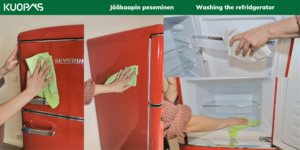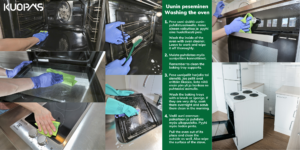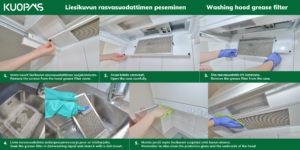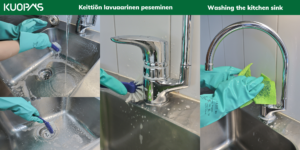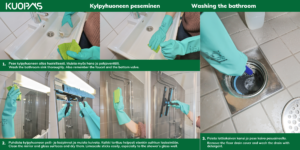Cleaning and home maintenance
Cleaning and Maintenance
You can read instructions for cleaning before leaving here.
1. Kitchen Cleaning & Appliances
🧊 Fridge
- Turn off the power before defrosting.
- Clean and defrost 2–4 times a year.
- Do not use sharp tools to remove ice.
- Wipe shelves, drawers, walls, door seals.
- Keep drain hole clean and unclogged.
- Clean behind and under if the fridge can be moved.
- Ensure ventilation slots are not blocked.
- Dry thoroughly before turning back on.
🔥 Stove and Oven
- Wipe cooktop after every use.
- Use non-abrasive cleaner suitable for the surface.
- Clean oven interior regularly to avoid grease build-up.
- Don’t forget oven trays and racks.
- Report oven light replacement via fault report.
- Do not use damaged or dirty pots on the cooktop.
🌀 Extractor Hood Filter
- Wash the grease filter monthly.
- Remove the filter gently and check fastening.
- Soak in dish soap, scrub, and dry thoroughly.
- Wipe down the hood’s outer surface.
🧽 Other Surfaces
- Wipe countertops with mild detergent.
- Clean cupboard doors and handles.
- Empty and wipe the inside of cabinets.
- Thoroughly clean trash cabinet.
- Wipe door frames, switches, baseboards.
- Clean sink and tap, remove limescale.
Dishwasher & Washing Machine – Don’t Forget:
- Only a licensed plumber can install or uninstall dishwashers.
- Always place a waterproof safety tray under the dishwasher.
- Never leave machines running unattended!
When Buying a Machine:
- Make sure it fits and connects correctly.
- Installation is at your own expense.
- Seller must provide proof of installation.
When Moving Out:
- Remove machine if the new tenant doesn’t want it.
- Reinstall original cupboard if removed.
- Cap all water connections properly.
Responsibility & Insurance:
- Kuopas does not install or uninstall machines.
- You are responsible for the machine and any damages.
- We highly recommend home insurance!
2. Bathroom and Toilet
💧 Floor Drain
- Clean at least once a month.
- Lift the cover → remove hair and gunk by hand.
- Scrub with dish soap and rinse well.
- Make sure the sealing plug is in place to avoid odors.
- If water doesn’t drain or it smells bad, report it.
🚿 Shower and Curtain
- Wipe walls, floor and curtain dry after use to avoid mold.
- Wash the shower curtain regularly.
- Clean lower wall tiles from limescale and soap.
- Check seams and tiles → report cracks or damage.
🧼 Sink, Toilet & Fixtures
- Clean basin and toilet regularly, ideally after each use.
- Remove limescale from faucets and surfaces.
- Clean trap (U-bend) if needed, or contact maintenance.
- Report leaking taps or toilets immediately.
- Do not flush trash, grease, or food down the toilet!
🌬️ Ventilation & Humidity
- Wipe ventilation grilles once a month.
- Never block or adjust the vent settings.
- If air feels damp or stale, make a fault report.
- Dry wet surfaces after showering.
- Keep the door open after showering to let air circulate.
3. Heating and Ventilation
Room temperature is maintained at 20–22 °C. Radiators may feel cool at times, that’s normal!
- System adjusts automatically based on outside temperature.
- Thermostats won’t heat above 22°C.
- Radiators feel cool when room temp is optimal.
- Do not vent radiators yourself, submit a fault report.
- Vacuum dust from radiator grills for better efficiency.
- The use of extra heaters is prohibited. An extra heater may shut down the apartment-specific heating and affect the heating system of the entire building. This will cause the temperatures in other apartments to drop.
💡 If your room feels cold, check:
- Are curtains or furniture blocking the radiator?
- Is the thermostat working normally?
Curtains and furniture block heat. Keep them at least 20 cm of space in front of radiators.
Exhaust air is removed from the kitchen, bathroom, and WC. Never block or adjust vents.
- System runs with automatic sensors (humidity, CO₂).
- Exhaust vents are located in wet rooms and kitchen.
- Do not close or adjust the vents, it affects building balance.
- Make sure air intake vents are not covered (above windows).
- Clean vents gently from dust, do no adjustments yourself.
4. Waste Sorting and Recycling
Sort your waste correctly! Here’s a quick guide to the main categories:
Food scraps, fruit peels, coffee grounds, napkins
Milk cartons, pizza boxes, cereal packages (flatten!)
Cans, foil, lids, caps, small metal items
Jars and bottles (no ceramics)
Food containers, detergent bottles, plastic bags
Items that don’t fit any other category
More info: Jätekukko’s sorting guide
5. Fire Safety and Lighting
- Test fire alarms monthly.
- Do not cover or remove smoke detectors.
- Do not use fryers or grills indoors.
- Follow building instructions if alarm goes off.
- False alarms caused by you will be charged.
Lights
You are responsible for buying and replacing regular bulbs, tubes, and starters. Special bulbs (oven, fridge) are replaced by Kuopas → file a fault report if needed.
Fuses
All apartments have a main electrical panel or box located in the entrance hallway. Most of the buildings are equipped with automatic fuses (switches that move up and down). The fuses are labeled to indicate which fuse controls what.
Tenants can check the main electrical panel themselves to see if any fuse is in a different position than the others. If so, the fuse can be switched back to the same position as the others.
Door Buzzers and Intercoms
Main doors stay locked 24/7. Guests use the buzzer to contact you. In newer buildings, intercoms allow you to see and talk to the visitor. Keep the system functional, it’s for your safety.
6. Renovations and Modifications
Kuopas is responsible for all renovations and refurbishments. If something needs fixing, submit a fault report.
- Do not drill or attach items to walls without permission.
- Do not adjust heating or ventilation systems.
- Do not perform electrical or plumbing work yourself.
- Dishwasher installations must be done by a professional.
7. Pests
🐞 Pests are not normal – report them right away!
In Finland, it is not normal to have insects or pests in your apartment. If you notice any signs of cockroaches, bedbugs, ants or other pests, you must report it immediately by making a fault report.
- Do not try to handle the issue yourself, pest control is arranged by Kuopas.
- The sooner it’s reported, the easier and quicker it is to fix.
- If you delay or fail to report, you may be responsible for the treatment costs.
🛠️ You can submit a fault report easily through our website.
Let’s keep your home safe and pest-free together!

